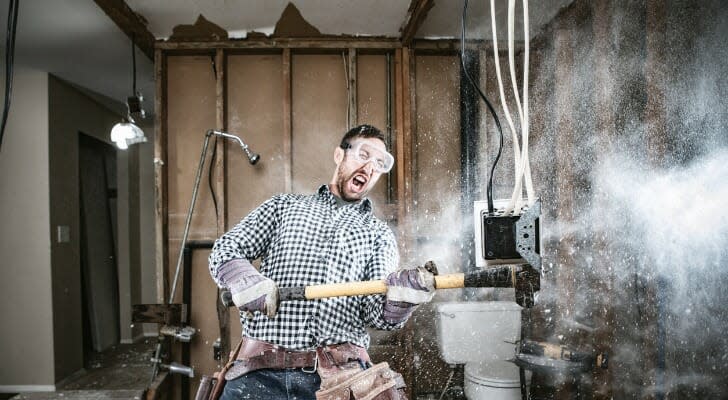A Beginner’s Guide to Flipping Houses for Profit

Last year, the average gross profit for house flipping was $65,000, according to property research firm ATTOM Data Solutions. This translates to an average 44.8% return on investment (ROI), which has been falling since the all-time average high of 51% in 2016. To net out a maximum profit, you can do such things as buy in the right neighborhood and choose only cost-effective renovations. This beginner’s guide on house flipping will walk you through all of this. A financial advisor can also help you explore and identify other investments with good ROI.
Invest in the Right Real Estate Market
Even if you buy a reasonably priced home and stay within your renovation budget, that doesn’t mean you’re going to sell for a big profit.
Studies show a wide disparity in the profits home flippers earned in different regions. According to a recent report by CNBC, the following places topped the list of best states to flip houses in for profit:
Tennessee
Pennsylvania
New Jersey
Los Angeles
Colorado
A different study Fortune published found flippers in the following cities saw a gross profit of more than 100%:
Reading, Pennsylvania (136.4%)
Pittsburgh, Pennsylvania (126.8%)
New Haven, Connecticut (104.8%)
Philadelphia, Pennsylvania (103.7%)
Of course, these areas may fall beyond your scope. Nonetheless, be sure to take a magnifying glass to home sales and house flipping profits in your location. Maybe you just need to venture an hour or so out of your zone to find a more profitable place to flip a house in. A Realtor can help you focus your search.
In addition, you should pay close attention to the neighborhood you invest in. What’s the income level and what’s the school district like? How about the crime rate? You can radically boost a dirt-cheap home, but it won’t sell as easily if it sits in a neighborhood with a recent spate of burglaries. Also, be wary of areas where homes are selling at a high rate. This could mean the local economy or neighborhood conditions are pushing people out.
Instead, you’re going to want to invest in places with high employment numbers, low crime rates and other signs that the neighborhood is thriving or quickly making its way up. Ultimately, you want to find an area that combines safety and economic growth with potential for a profitable house flip. As you go about your strategic decision-making process and meet with an expert, make sure you know which questions to ask a financial advisor before your initial meeting.
Create a House Flipping Budget
Once you have a sense of your target neighborhood and going prices for houses in it, it’s time to set up a house flipping budget. First, you need to know what you can reasonably pay for a new home. Our how much house can you afford calculator can give you a clear picture.
Certainly, buying with all cash is the simplest route for home flippers. It cuts out the mortgage application and approval process as well as makes your offer more attractive to sellers. Plus, you won’t need to make ongoing interest payments for the property as the renovations are underway.
Still, some house flippers – 39% in 2018, according to ATTOM – needed financing. If that’s the route you’re taking, read our articles about FHA loans and best mortgage lenders.
Once you nail down the amount you’ll need for the actual house, you should explore the costs of potential projects. Many people drop the ball here by failing to take the housing market into account. For example, if neighborhood prices top out at, say, $100,000, and you pay $50,000 for the house alone, a $35,000 kitchen upgrade is going to eat into your net profit in a serious way. In this instance, you might want to limit the kitchen remodeling to $15,000. (HomeAdvisor reports that homeowners typically spend $12,559 to $34,662 on kitchen renovations.)
When calculating how much you think you can get for a house, aim for the lower end of comparable sales prices. This will give you more wiggle, should your renovations go over budget.
Now that you know how much you can and should spend, you’re almost ready to start shopping for a house, and financing if you need it. To maximize your return, you still need to double check that you’re taking everything into account. There are likely some big factors that may not be on your radar.
Know the Real Costs and Risks of House Flipping

Home flipping has been popularized by major networks like HGTV, but 30-minute recaps of only successful projects fail to capture the real costs in not only money but physical effort.
So let’s start by exploring the real price tag alone. We gathered some data from the 2019 Costs vs. Value report by Remodeling magazine. Below, we break down average costs of popular home improvement projects. But keep in mind we deal with only national averages here. Prices can vary significantly by factors like location and materials. But we differentiate between midrange and upscale variations. We also include average resale value for each project.
2019 National Average Costs of Home Improvement Projects Project Average Cost Resale Value Midrange bathroom addition $47,427 $28,726 Upscale bathroom addition $87,704 $51,000 Midrange Bathroom remodel $20,420 $13,717 Upscale bathroom remodel $64,743 $38,952 Midrange major kitchen remodel $66,196 $41,133 Upscale major kitchen remodel $131,510 $78,524 Midrange metal roofing replacement $38,600 $23,526 Midrange backyard patio addition $56,906 $31,430
As you can see, these projects on average returned around 55% to 76% in cost recouped. But don’t be discouraged. Many of these home flippers likely failed to budget their project properly. They may have also overspent on their renovation in the long run.
If you’re depending on financing to pay for the renovations, those costs are also going to hurt your bottom line. Be sure to explore all your options, including a home improvement loan, second mortgage and credit to finance your house flip.
You want to care that you don’t overextend yourself. Also, you don’t want to make the rookie mistake of thinking you’ll save money by doing a lot of the work yourself, so you spend more on materials. If you’ve never retiled a bathroom before, it may take you longer than a professional would take, and time is money when you’re paying interest for your financing. In the end, it may have been cheaper to hire a professional from the get-go, especially if you have to ask one to redo your work.
Of course, you can do light cosmetic upgrades like painting and stripping woodwork. But leave projects involving plumbing, electrical and structural changes to the professionals. That said, don’t just go for the cheapest labor. This is a big investment you’re making and you’re going to need the right talent. So make a thorough search for contractors and read online reviews. And ask your friends and family for any recommendations.
You should factor in the size of the home as well. After all, a renovation on a large home will cost more than the same project in a smaller one by virtue of it requiring more materials. It’ll also take more time, which, as mentioned earlier, is valuable if you borrowed money for this investment. Something to be aware of: FitSmallBusiness reports that experienced flippers can complete the entire flip within 90 days.
Sell the Home
While you’re likely fine buying the house alone, you definitely need a professional to help you sell it. If you don’t have a realtor already, aim to interview several. You want someone who can give you a thorough analysis of an after-repair value for the home. You also want someone with a great track record of selling properties in your area for top dollar. Finally, only sign on with someone you like and trust.
To make sure you’re doing all you can to help sell the house, take a look at our guide on how to sell your house.
The Takeaway

Flipping houses can be a lucrative business venture if you do it right. But you can run into several pitfalls along the way. You can avoid these by sticking to the following:
Research different real estate markets and find a thriving neighborhood where you can find a low-cost home with an affordable mortgage that you can reasonably sell for a profit.
Find a project that fits your budget and keep it small in scope if you’re a beginner.
Develop a house flipping budget that is realistic and covers everything, including purchase price of the home, financing for any loans, labor, materials and professional fees.
Keep costs down while you renovate and work with a realtor and financial advisor for professional guidance.
House Flipping Tips
Hire the contractor before you buy. A contractor’s fees may cut into profit margins when you’re tackling a home improvement project, but his professional evaluation of houses will save you hundreds, if not thousands, down the line.
Start small if that means you can cover all expenses with cash. Without the time pressure that financing adds, you can be a bit more relaxed if renovations or selling takes longer than expected. It also gives you a little more flexibility when it comes to sales price.
Talk to a money professional. Flipping houses will affect your cashflow and finances. A financial advisor can make sure this venture doesn’t run you off track with your long-term goals. To find the best professional for you in your area, use our SmartAsset financial advisor matching tool. It pulls up data on up to the top three, based on your personal goals. You can evaluate their qualifications and meet them in person before deciding to work with one.
Photo credit: ©iStock.com/alabn,/©iStock.com/RyanJLane, ©iStock.com/Kerkez
The post A Beginner’s Guide to Flipping Houses for Profit appeared first on SmartAsset Blog.

 Yahoo Finance
Yahoo Finance 